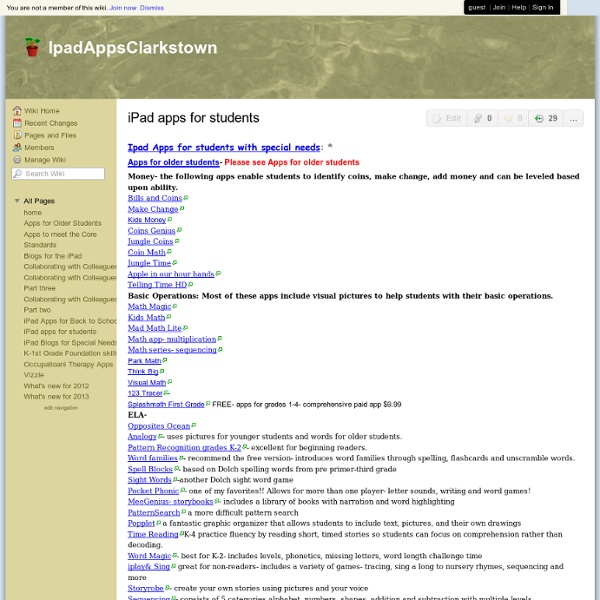



Class Widgets - Custom Widgets for iBooks Author A List of Some of The Best iPad Resources for Teachers Educational Technology and Mobile Learning has devoted a lot of its space to iPad and its educational usage. I know Android is not as much covered as iPad but as I have said before my second blog Teacher's Mobile Technology has all the educational apps and tips on how to use both Android and iPad, check it out and subscribe to stay updated about the future releases. Today's post is a culmination of all the hard work we have been doing here during this year. We have curated a list of some of the best iPad resources for teachers and educators. These are resources that we trust as being highly educational and can help you a lot in your daily search for apps to use with your students. Check them out below and let us know what we have missed. 1- Cybraryman's iPad Page I am so impressed by the great work this man does in his website. 2- Teacher's Mobile Technology This is our second blog where we feature daily reviews of the best educational apps for both Android and iPad. 3-Teachers with Apps
quietube | Video without the distractions | Youtube, Viddler, Vimeo and more Teaching Creativity - Professional Development for Teachers A few weeks ago fellow Voices blogger Shelley Wright wrote a provocative blog on flipping Bloom’s Taxonomy and beginning the learning experience with Creativity. As the person most directly responsible for our school’s Professional Development I have been wondering what professional development looks like when you turn Bloom’s on its head. Teachers young and old are comfortable with the old model and path. Even if they have never heard of Bloom’s Taxonomy (it happens in independent schools where some young teachers have never taken an education course), teachers are inherently comfortable with the approach the taxonomy lays out. Remembering and Understanding are sooo easy to assess—give a quiz; find out what you student doesn’t know. Ongoing education for teachers in all of Bloom’s Taxonomy except for Creativity is relatively straightforward. Encouraging teachers to teach creativity requires a different approach. Why teachers who create do Creativity so well Teaching Creativity is messy
Beautiful web-based timeline software How do you teach creativity? Creative Ideas & Inspiration Blog Posted January 3rd, 2013 at 7:00 am by Tanner Christensen If we look at creative thinking as the act of coming up with new ideas (new to the thinker, not necessarily to the world at large), what’s the best way to teach that ability? Is it something you can even teach? The best possible answer – which I’m going to touch on a lot this year on Creative Something – is undoubtedly “Yes!” You can teach creative thinking, but it’s not about teaching arts or expression necessarily, it’s more about teaching students to be curious and how to ask good questions. Here’s why. When you believe that all you need to know is already laid out before you, new ideas will still develop on their own (since it is in our brain’s nature to connect ideas in order to better understand the world around us), but moments of creative insight will be few and far between since you’re content with what you know. Instead, to teach creativity, you have to teach the importance of knowing that we don’t know a lot.
Ipadschools - home Finland's schools flourish in freedom and flexibility | World news At Meri-Rastila primary school in a suburb of Helsinki, pupils shake the snow off their boots in the corridors, then peel them off and pad into class in socks. After a 45-minute lesson, they're out in the playground again. The Finnish school day is short and interspersed with bursts of running around, shrieking and sledging outdoors. Children start when they're older, the year they turn seven and there is no pressure on them to do anything academic before then. The Finnish education system contrasts sharply with England. There are no league tables, and no school inspections. Meri-Rastila's principal, Ritva Tyyska, said: "I think it's quite good that they don't rank the schools because we have good teachers, we have a curriculum and we have to obey it. "We have these tests, in the fifth or sixth forms, that are the same tests at each and every school. In Finland, the state decides what should be taught, but not how. Finland's success is due, in part, to the high status of teaching. Exams